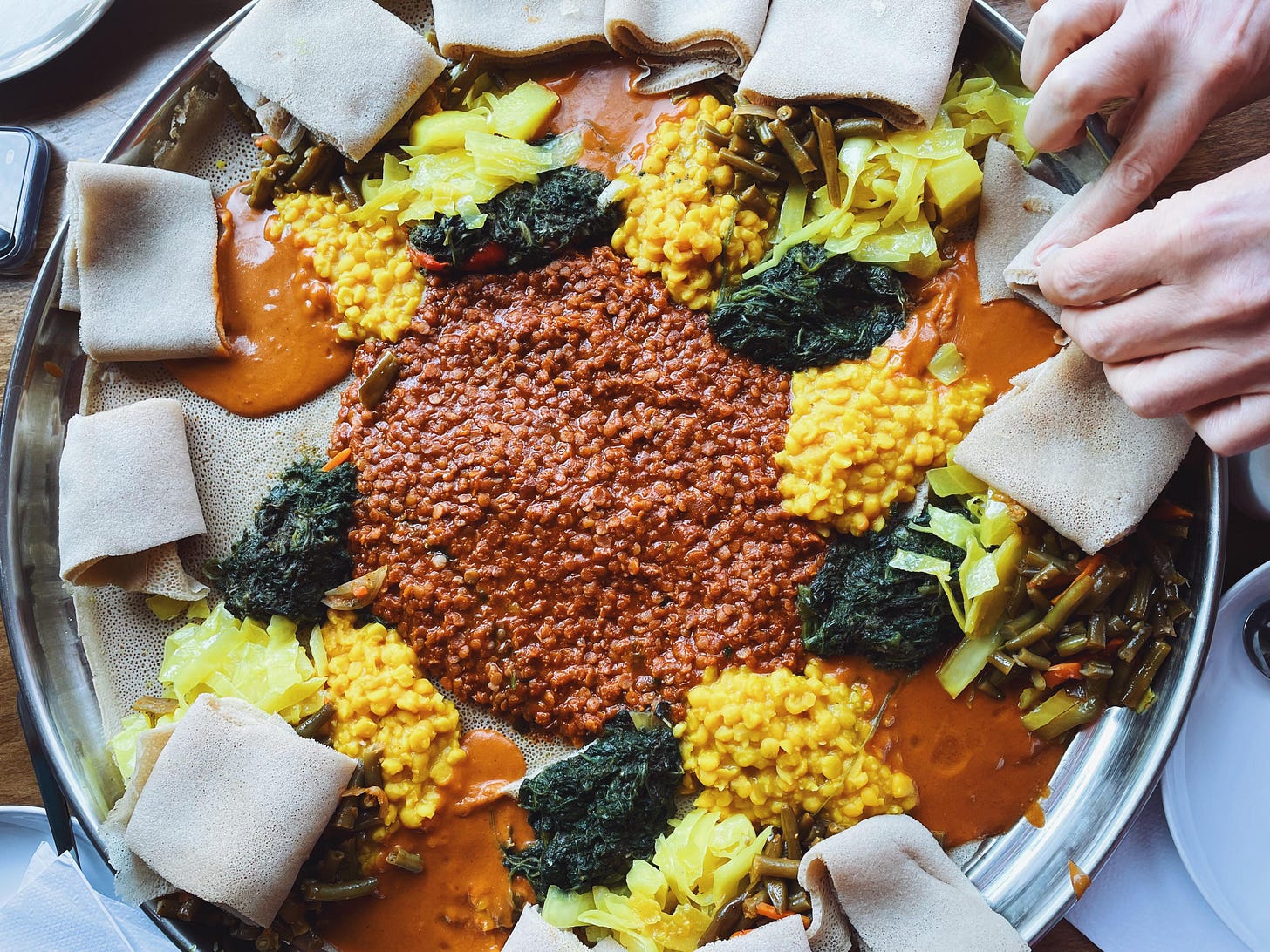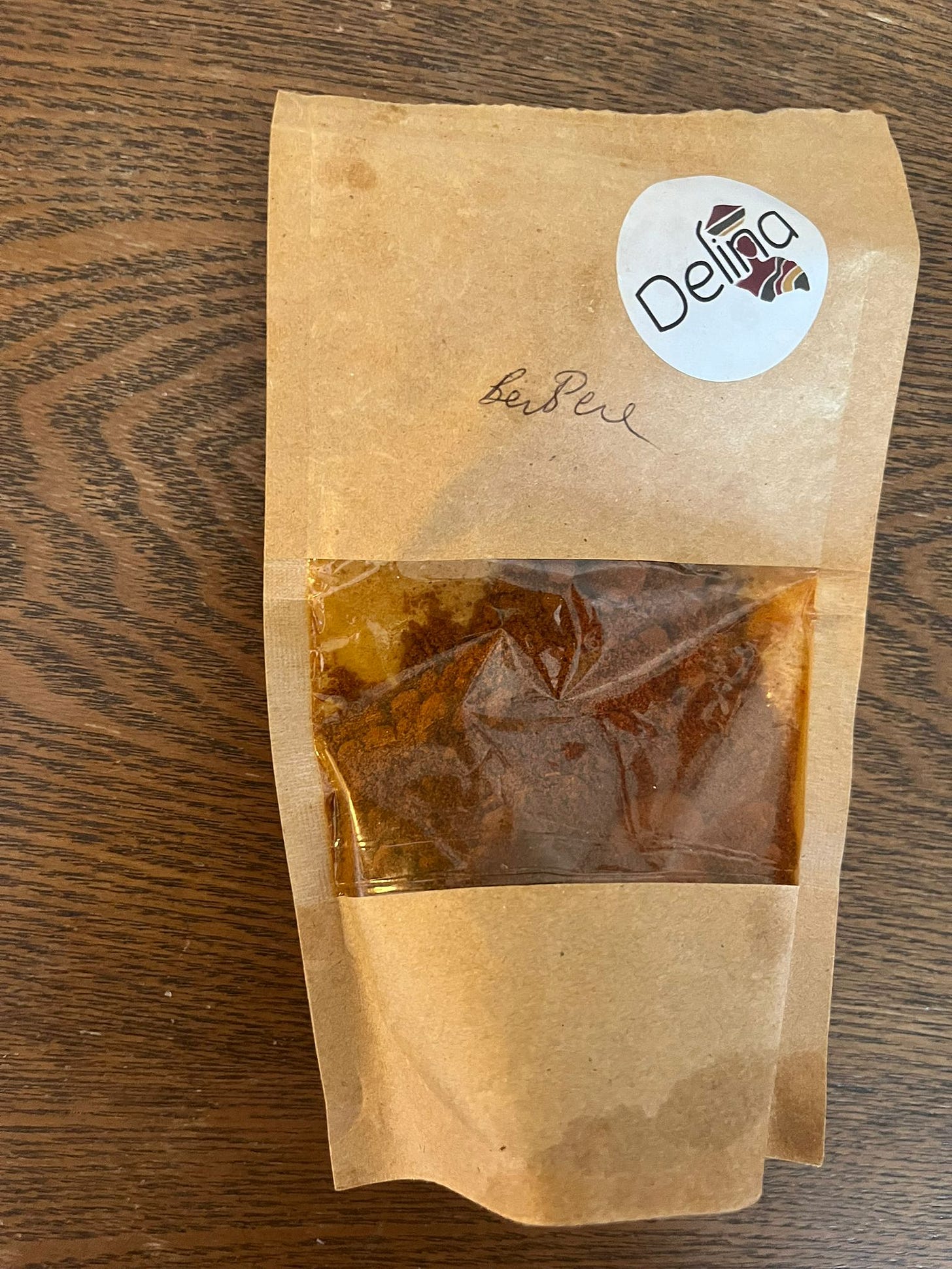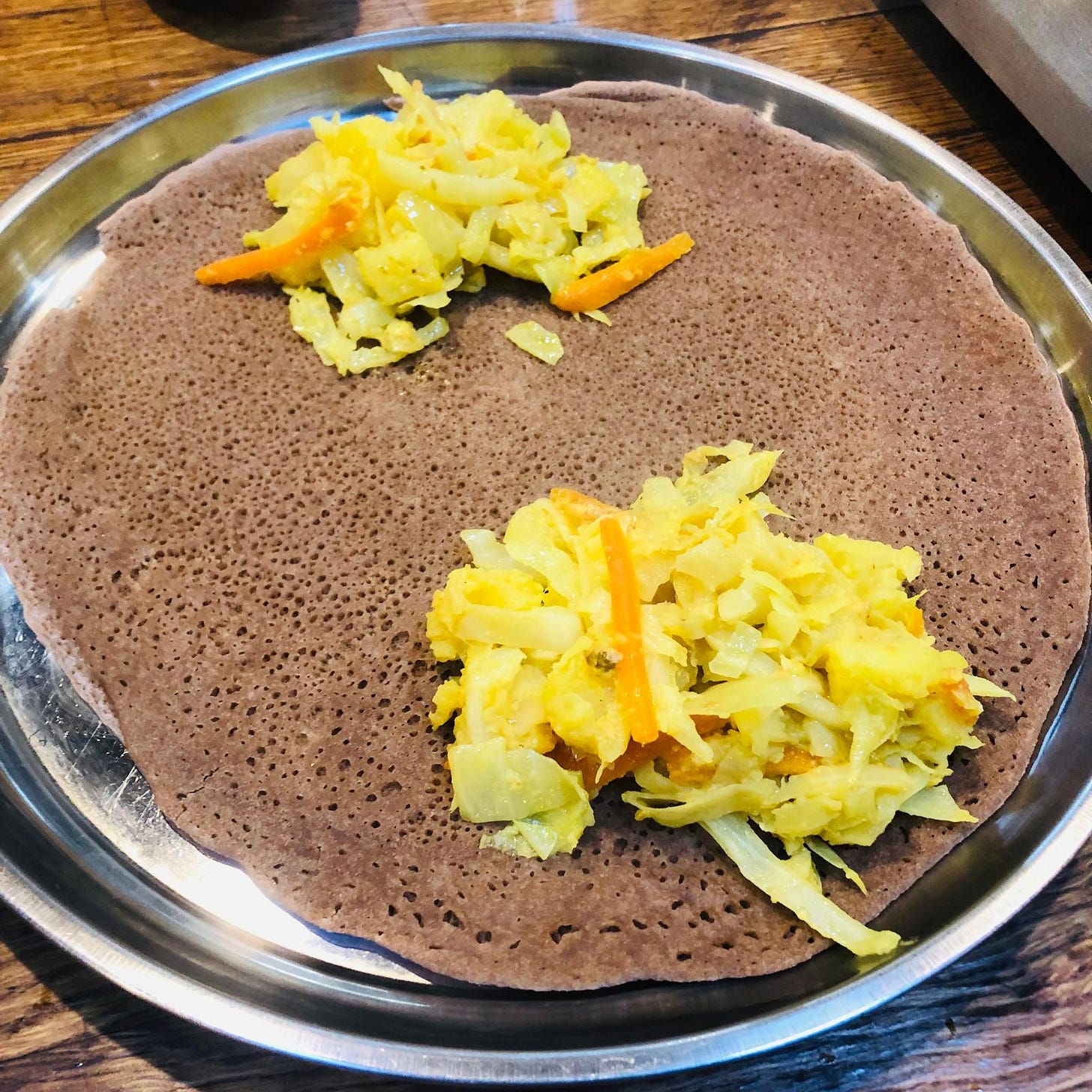Beyaynetu at Merkamo Ethiopian, just off Brick Lane (best to avoid the food on Brick Lane itself)
Ethiopia, the cradle of humankind and civilisation, is often overlooked in the culinary world. At least, that’s what I feel. Deeply rich in history, culture and cuisine, Ethiopian food is a real treat for the senses, and worth exploring. You’ll be surprised by just how easy the recipes are below. And you might just find, like me, that you crave this wonderful cuisine often.
Lucy, possibly the most famous fossil in the world, was discovered in Ethiopia’s Hadar region and dates back over three million years. Science tells us that she would have been an excellent forager, and lived on a predominantly plant-based diet. There was no hunting or tools to hunt, so survival was based on seeds, leaves, tubers and the like.
Ethiopian food is also interesting in that the nation is one of only two in Africa that have never been colonized, despite several attempts by the Italians. Personally, I’m glad that regardless of Italy’s short-lived occupation of Ethiopia, pasta didn’t ingrain itself in the national psyche, and they’ve stuck with a range of delicious, well-spiced stews and slow cooked veg dishes.
Those are my eager fingers, dear reader, tucking into this platter at Andu on Kingsland Road
Enebla!
When Ethiopians meet – whether family, friends or strangers, it’s common to say ‘Enebla’ — ‘let’s eat’, and so I’m deeply in love with the culture, of course. I have family and friends who don’t even offer a glass of water to a visitor, dammit.
The culture is very food-centric, and another beautiful thing I learnt some years ago is that the people enjoy feeding each other. The practice of ‘gursha’ translates as ‘mouthful’ into English, and by feeding someone else, either with your hand or a spoon, you are showing love and respect to another. I think my first taste of Ethiopian food was at a restaurant called gursha, in fact. So there you go.
Anyone honoured with a mouthful of offered food is expected to return the favour. In our house, I think that would quickly turn into a food fight, but then I’m a disrespectful asshole.😊
The rock-hewn churches of Lalibela are a UNESCO world heritage site, and testament to the country's rich history and unique architectural achievements
I dream of fasting days…
Religion looms large in Ethiopian culture. The country is mostly Christian, with Ethiopian Orthodox, Pentay (a short form of Pentecostal), and Roman Catholic being prevalent. The food certainly makes you feel closer to God.
Each religion has a fasting period, with times varying, based on which faith you follow. Followers of the Ethiopian Orthodox fast seven times a year, including for Lent, 55 days prior to Easter (Catholics fast for 40 days for Lent). And they fast every Wednesday and Friday throughout the year. During fasting - which for some people, amounts to 200 days a year - people abstain from all animal products. These fasts are why Ethiopia offers a paradise for vegans.
The Ethiopian fasting platter is commonly called beyaynetu — sometimes referred to as fasting beyainetu or ye-tsom beyaynetu (ye-tsom meaning “of the fast” in Amharic).
Support me in my quest for another traditional Ethiopian coffee ceremony….by buying me a virtual buna, here
Beyaynetu comprises a colourful assortment of plant-based dishes served atop a giant piece of injera bread. It typically includes lentil stews (like misir wot), chickpea flour stews (shiro), spiced greens (gomen), cabbage and carrot dishes (atkilt alicha), beetroot salad (key sir), and injera, the soft, pancakey bread which is a must. I’ve provided versions of all these recipes below, so you can pay your own respects to your own gods through the joy of this beautiful food.
Even outside fasting times, many Ethiopians enjoy beyaynetu simply because of its great flavour and variety.
And given the traditional preference for eating in groups, it’s hard to make Ethiopian food for one. When you cook it, remember it often improves in flavour overnight, and leftovers never stay left over for long. It’s freezable, too.
Having said that, Ethiopians are generally huge meat lovers, with “tibs-style” meat dishes prepared as a symbol of respect, often taking centre stage at family gatherings.
Of course, most meat-based tibs recipes are easily and readily veganised, as Richa proves, here.
As long as you make your hosts aware of your preferences, Ethiopians can and most certainly will pull out a wide repertoire of super tasty vegan dishes that are sure to make you very happy indeed.
The recipes below, in my typical style, are mostly fast and easy. I don’t like cutting corners, but hope that you’ll be rustling up a five-dish fasting meal in no time, and that the recipes are added to your kitchen repertoire on repeat.
Me, all proud of my cooking attempts at Delina a few years back…
RECIPES
A few years ago I did an Ethiopian cookery class, gifted to me by my amazing partner, Nico, who also took part. Naz, the restaurant owner and teacher, took us through a bunch of pretty basic and easy dishes, which really ignited a passion in me for Ethiopian food - especially the gigantic sharing dishes, which are tasty, fun and easy on the tum.
When is a wot not a wot?
To make a good wot – stew - you need to add the spice mix, which is everything, and what (wot) makes your wot hot or not. Berbere spices are the heart of a lot of the food, and there are numerous recipes, which, if you’re craving authenticity, are a wonderful blend of unusual tastes.
However, dear reader, for you to enjoy Ethiopian food at home, I’ve done the leg work, and created a simpler version that you can make with readily available stuff. Some recipes call for ingredients like Korarima seeds, African long peppers (Timiz), passion berries and Ten Adam, or rue, which I had to look up. It's Herb of Grace, but I'm none the wiser. And despite its beautiful name, it's described as bitter and dangerous, like Trump at a UN conference. So I'm leaving it out.
With the below recipe, I hope not to offend or cause a culinary spat, I’m merely offering an homage to Berbere.
My trusty old bag of berbere, from Delina in Shepherd’s Bush market
Berbere Spice Mix
Ingredients
6 dried red chillies, seeds removed for milder heat (or keep seeds for spicier blend)(some recipes call for 20 or more chilies, so you do you!)
1 tablespoon coriander seeds
1 tablespoon cumin seeds
1 tablespoon fenugreek seeds
1 teaspoon black peppercorns
1 teaspoon whole allspice
6 cloves
10 cardamom pods
1 teaspoon nigella seeds (optional but traditional in some regions)
2 teaspoons ground ginger
1 teaspoon ground cinnamon
1 teaspoon ground turmeric
1 teaspoon sweet paprika
½ teaspoon ground nutmeg
2 tablespoons garlic powder
1 tablespoon onion powder
2 teaspoons salt
Top tip: Buy it, if you can’t be bothered. But buy it from an Ethiopian restaurant, if you can, as it will be fresher and more authentic than dusty old supermarket packets.
Preparation
Begin by gently toasting the dried red chillies in a dry frying pan/ skillet over low heat for 2 to 3 minutes, stirring frequently, until they are fragrant but not burned. Remove from the skillet and let cool.
In the same pan, toast the coriander seeds, cumin seeds, fenugreek seeds, peppercorns, allspice, cloves, cardamom pods, and nigella seeds if using. Toast for about 2 minutes, stirring constantly, until the spices release their aromas. Remove from the heat and allow to cool completely.
Once cooled, grind the toasted chillies and spices together in a spice grinder or mortar and pestle until you have a fine powder.
Transfer the ground spice mixture to a bowl. Stir in the ground ginger, cinnamon, turmeric, sweet paprika, nutmeg, garlic powder, onion powder, and salt. Mix thoroughly until everything is well combined.
Store the berbere spice mix in an airtight jar in a cool, dark place. It will keep well for several months, and the flavours may deepen over time.
Shiro Powder
(Serves as a base for several dishes)
Shiro is deeply woven into the culinary and cultural fabric of Ethiopia and Eritrea. The term shiro is derived from the Amharic word ሽሮ (širo), meaning “ground powder” or “puree,” referring to the finely milled legume base. The dish made from it is often called shiro wot (wot meaning stew).
Shiro has its roots in humble, everyday cooking. Traditionally, it was a staple during fasting periods observed by followers of the Ethiopian Orthodox Church, as it is plant-based and rich in protein. Its simplicity, affordability, and satisfying nature have made it a well-loved dish across regions and social classes. Over centuries, families developed their own variations of the spice mix, with some adding more heat, herbs, or even a touch of berbere for extra depth. Again, this version is an easy win at home.
Ingredients
1 cup chickpea flour (you can also use roasted chickpeas ground finely, or a blend of chickpea and broad bean/fava flour)
1 tablespoon garlic powder
1 tablespoon onion powder
1 teaspoon ground ginger
1 teaspoon ground basil (optional, traditional in some regions)
1 teaspoon ground cardamom
½ teaspoon ground fenugreek
½ teaspoon ground coriander
¼ teaspoon ground black pepper
Salt to taste
Preparation
In a bowl, combine the chickpea flour with all the ground spices and salt. Mix well so the blend is uniform.
Store your shiro powder in an airtight container in a cool, dark place. It will keep for several weeks.
When ready to use, the powder is typically cooked with oil, water, and sometimes tomato paste or fresh garlic to form a thick, hearty sauce served with injera or bread.
Niter Kibbeh (Ethiopian Spiced Butter)
Traditionally, this is basically flavoured ghee, and used in many recipes to add a richness and flavour. However, I’ve left it out in favour of oil…but if you want to attempt a more authentic approach, here’s a veganised version. Where I mention oil below, use this instead.
Ingredients
1 cup refined (unflavoured) coconut oil
1 small onion, finely chopped
3 cloves garlic, minced
1 teaspoon grated fresh ginger
1 teaspoon fenugreek seeds
1 teaspoon cumin seeds
1 teaspoon coriander seeds
½ teaspoon cardamom seeds (from green pods)
½ teaspoon ground turmeric
¼ teaspoon ground cinnamon
1 small piece of dried African long pepper (optional but authentic)
Preparation
Melt the coconut oil slowly in a small heavy-bottomed saucepan over low heat. As the butter begins to melt, add the onion, garlic, ginger, fenugreek seeds, cumin seeds, coriander seeds, cardamom, turmeric, cinnamon, and long pepper if using.
Let the mixture simmer very gently, uncovered, over low heat. It should bubble lightly but not brown. Cook for about 20 to 30 minutes, stirring occasionally.
Remove from the heat and let it sit for a few minutes so the spices can settle. Strain the liquid through a fine mesh sieve or cheesecloth into a clean, dry jar or container, discarding any solids.
Allow to cool. The niter kibbeh will solidify as it cools and can be stored, covered, in the refrigerator for several weeks. You may find finger prints or bits of injera in it. That’s normal…
Top tip: Try brushing this on corn on the cob, or your homemade seitan for a flavour bomb!
Ethiopian base sauce
Ethiopian cuisine is almost colour-coordinated. Where you see a deep red, it will be spicy, which means you’ll probably find berbere spices. These will typically be called ‘Kay Wot’. Mild dishes are usually yellow, and typically called ‘Alicha Wot’. Before you start cooking Ethiopian dishes, Naz, our cookery class teacher, explained that it’s best to learn the foundational sauce which can be transformed into many of these dishes.
Ingredients
2 medium onions
2 Tbsp berbere spice (Add more or less to adjust spice level) For mild Alicha Wot, or if you can’t find or make berbere, you can use 1/2 TSP of turmeric and 1/2 TSP cumin instead
1 medium tomato
3-4 cloves of garlic
Half a thumb of ginger
4 Tbsp vegetable oil of your choice
1/2 Tbsp olive oil (optional ingredient ideal for protein dishes to make the sauce rich and glossy)
Preparation
Finely chop all the ingredients
Before adding the oil and other ingredients, gently cook the finely chopped tomatoes and onion on medium heat until all moisture is evaporated. It should be dry.
Add the vegetable oil, garlic, ginger and berbere spices
Continue to cook on medium heat for up to 15 minutes until all the ingredients are combined.
Towards the end, just before serving, add your ghee or olive oil.
This recipe is ideal for 2-3 meals
Top Tips from Naz: Add a little bit of water if it starts to stick to the pan. Use a food processor to finely chop ingredients for speed, and simply add your choice of protein or vegetables to create your desired dish (making sure to continue cooking depending on what you decide to add. For lentils - until they are soft, for example.)
Misir Wot - Spicy Lentils
Ingredients
A portion of the base sauce, above
3/4 cup of red split lentils
Salt to taste
Preparation
Wash the lentils and put them aside.
In a large medium heat saucepan, add the washed red split lentils to your base sauce.
Stir occasionally to make sure the lentils do not stick, and add a splash of water whenever it becomes dry or sticky.
Add salt to taste
Repeat this for 15-20 minutes until the lentils are tender and saucy, but not mushy.
Serve with injera (Ethiopian flatbread) or rice or salad.
Shiro Wot (Chickpea Flour Stew)
Ingredients
¾ cup shiro powder (see above)
1 large onion, chopped
2 cloves garlic, minced
2 tablespoons vegetable oil
3 cups water
Salt, to taste
Preparation
Heat the oil in a pot over medium heat.
Add onion and garlic, cooking until soft.
Add the water, then stir in the shiro powder gradually, whisking to prevent lumps.
Simmer over low heat, stirring frequently, until the stew thickens and becomes smooth, about 15 minutes.
Season with salt and serve hot.
What kind of wot now?
Atkilt Alicha (Mild Cabbage, Carrot, and Potato Stew)
Ingredients
2 tablespoons vegetable oil
1 onion, sliced
2 carrots, sliced
2 potatoes, peeled and chopped
½ head of cabbage, sliced
1 teaspoon turmeric
Salt and pepper, to taste
½ cup water
Preparation
Heat the oil in a large pan over medium heat.
Add the onion and cook until soft.
Stir in the turmeric.
Add the potatoes, carrots, cabbage, and water. Season with salt and pepper.
Cover and cook until vegetables are tender, about 25 - 35 minutes, stirring occasionally.
Add a little more water if it gets dry, or starts sticking to the pan base.
Fasolia (Green Beans and Carrots)
Ingredients
2 tablespoons vegetable oil
1 onion, sliced
2 cloves garlic, minced
2 cups green beans, trimmed and cut in half
2 carrots, sliced
1 tsp (5g) of tomato paste
0.5 tsp (1g) of Berbere
0.25 tsp (0.5g) of basil
0.5 tsp (1g) of garlic powder
1 medium (15g) seeded and sliced hot green pepper (jalapeno, optional — and simply throw it in at the end of cooking)
0.25 tsp (0.5g) of black pepper
0.25 tsp (1.5g) of salt
Preparation
Heat the oil in a pan over medium heat.
Add the onion and garlic, cooking until soft.
Add the green beans and carrots, and season with salt and pepper.
Next, add the tomato paste, garlic, basil, Berbere, black pepper, and salt, along with 0.5 cup of water.
Cover and cook, stirring occasionally, until the vegetables are tender but still vibrant, about 10 to 12 minutes.
Inspired by Naz, and this recipe here.
Gomen (Ethiopian Collard Greens or Kale)
Ingredients
2 tablespoons vegetable oil
1 onion, chopped
2 cloves garlic, minced
1 teaspoon ginger, minced
1 tsp turmeric powder
1 bunch collard greens or kale, chopped
½ teaspoon salt
¼ cup water
Preparation
Heat the oil in a large pan over medium heat.
Add the onion, garlic, and ginger, and sauté until soft.
Add the greens, salt, turmeric and water.
Cover and cook, stirring occasionally, until the greens are wilted and tender, about 10 to 15 minutes.
Ethiopian Key Sir (Beetroot Salad)
This is a banging addition to any Ethiopian—inspired meal.
Ingredients
4 medium beetroots (beets)
1 small red onion, finely chopped
2 tablespoons lemon juice (or lime juice)
2 tablespoons olive oil or vegetable oil
Salt, to taste
Black pepper, to taste
1 small green chilli, finely chopped (optional for a bit of heat)
Preparation
Wash the beetroots thoroughly and place them in a pot of water. Bring to a boil over medium heat and cook until the beets are tender when pierced with a knife, about 30 to 40 minutes depending on their size.
Once cooked, drain and let the beets cool enough to handle. Peel the skins off (they should slip off easily). Cut the beets into small cubes or thin slices, depending on your preference.
In a bowl, combine the cubed or sliced beets with the finely chopped onion and green chilli if using. Drizzle over the lemon juice and olive oil. Season with salt and black pepper to taste. Toss gently to mix well.
Allow the salad to rest for at least 15 minutes at room temperature so the flavours meld. Serve at room temperature or chilled as part of an Ethiopian platter.
Easy Injera (Makes 4–6 large injera)
Ah, injera. It’s chewy, but soft, comforting but a little surprising, if you’re not used to the ‘fermented’ twang. It’s also super good for you, and not as complex to make as you might think. This easy and approachable injera recipe uses a mix of teff flour (the traditional grain) and plain flour to make it simpler, while keeping the authentic taste and texture. True injera is naturally fermented over several days, but there’s also the option of a quicker version, which still gives good flavour and the signature spongy texture.
Ingredients
1 cup teff flour (or substitute with wholemeal flour if teff is unavailable)
1 cup plain white flour
2 cups water (plus extra if needed for thinning)
½ teaspoon salt
½ teaspoon instant yeast (optional, speeds fermentation)
Preparation
In a large bowl, combine the teff flour, plain flour, and salt.
Gradually whisk in the water to form a smooth batter.
If using, stir in the yeast.
Cover the bowl loosely with a clean cloth or plastic wrap and leave it at room temperature for 1 to 2 days to ferment lightly. The batter should develop small bubbles and a slightly tangy aroma.
If you’re short on time, you can let it rest for just a few hours and still get decent flavour. Leaving it overnight, however, makes sense.
When ready to cook, stir the batter gently. The consistency should be similar to thin pancake batter. Add a little more water if it seems too thick.
Heat a large non-stick frying pan or a traditional flat griddle over medium-high heat. Lightly oil the surface if needed. Pour a ladleful of batter into the centre and quickly tilt or swirl the pan to spread the batter in a thin, even layer. Cover the pan with a lid.
Cook for 1 to 2 minutes until the injera sets and the surface is covered with bubbles and holes (these are key for texture). The edges will lift slightly, and the injera should look dry on top without flipping. Remove from the pan and let cool on a clean cloth.
Repeat with the remaining batter. Serve the injera warm or at room temperature as the base for your platter, and roll up pieces to serve alongside your dishes.
BONUS RECIPE (Because I love a good soup)
Misir Shorba (Lentil Soup)
Despite never having been colonised, Western-style soups have crept onto the menus of many Ethiopian restaurants, and into people’s homes. But this is a tasty recipe, and more akin to the Middle Eastern lentil soups you see everywhere – with an Ethiopian twist. The recipe comes from the book ‘Enebla’ by Luladey Moges.
Ingredients
2 cups brown lentils
1 large yellow onion, diced
3 cloves garlic, finely chopped
3 tablespoons vegetable oil or olive oil
2 tablespoons berbere
½ teaspoon ground cumin
1 teaspoon ground ginger
1 can diced tomatoes
3 cups water
2 dried bay leaves
Salt and pepper, to taste
Preparation
Rinse the brown lentils under cold water. Place them in a pot and add enough water to cover the lentils by about 2 inches. Bring the pot to a boil over medium heat.
Let the lentils cook, stirring occasionally, until they are al dente, which should take about 5 minutes. You want them to be tender but not fully cooked or mushy.
Drain the lentils and set them aside.
In a pot over medium heat, add the vegetable oil or olive oil, and the diced onion and garlic. Stir occasionally, until the onions and garlic are starting to brown. This should take about 5 minutes.
Stir in the berbere, ground cumin, and ground ginger. Mix well so that the spices are evenly distributed and not clumping together.
Add the can of diced tomatoes. Pour in the 3 cups of water and stir everything together. Bring to a boil.
Once boiling, stir in the pre-cooked lentils. Reduce heat to low. Add the dried bay leaves and season with salt and pepper to taste. Stir everything together again.
Cover the pot and let the stew cook gently over low heat, stirring occasionally, until the lentils are fully cooked and tender. This should take about 10 to 15 minutes.
Remove the pot from the heat. Discard the bay leaves and serve the soup hot.
An American version of beyaynetu 🤣🤣 I ate some of this, dear reader, but I know which dish I prefer…
That’s all folks! Looks like a heatwave in the UK, or what more normal countries refer to as ‘summer’. So what better time than to rustle up a good Ethiopian platter, and ship it to the garden or park?












Wonderful overview of & recipes from one of the world's great cuisines. And so vegan-friendly!
Love Ethiopian food!